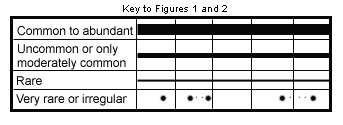

Red Knot (Calidris canutus). Uncommon migrant and uncommon to rare summer and winter resident along coast; very rare migrant inland. Late spring records may pertain to summering individuals rather than late migrants. Numbers of winter and summer residents vary per year; largest concentrations recorded on SE coast (Grand Isle, Fourchon) and on barrier islands (counts up to 200 in summer not uncommon; much less numerous in winter). Less numerous on SW coast. Juvenals, which account for most fall migrants, occur early September to late November. Beaches, mudflats.
Sanderling (Calidris alba). Common migrant and winter resident along coast; smaller numbers spend summer. Spring migration peaks mid- May. Fall migrants return early July (adults); juvenals by mid-September. Rare migrant through interior. Primarily coastal beaches.
Semipalmated Sandpiper (Calidris pusilla). Common to abundant migrant throughout state. Spring transients occur late March to early June, uncommon to rare to mid-June. Fall migrants arrive early July (adults); juvenals appear early August; present through late September, rarely to early November. A few occasionally summer (late June to July) along coast. No documented winter records. Mudflats, beaches.
Western Sandpiper (Calidris mauri). Common to abundant migrant throughout state. Spring transients occur early March to late May; peaking during April. Fall migrants return early July (adults) through late September; first juvenals arrive early August. Common to abundant winter resident along coast and interior SW; rare elsewhere in interior during winter. Small numbers occasionally summer along coast (mid-June to early July). Mudflats, beaches.
Least Sandpiper (Calidris minutilla). Common migrant throughout state. Spring transients present mid-March to early June. Fall migrants arrive early July (adults); juvenals mid-August. Uncommon to common winter resident, scarcer in N Louisiana. Small numbers occasionally summer along coast (mid-June to early July). Mudflats, wet plowed or grassy fields.
White-rumped Sandpiper (Calidris fuscicollis). Abundant spring migrant in SW Louisiana; scarcer in SE and N Louisiana. Spring transients present mid-April through mid-June, rarely to late June and early July, peaking in mid- to late May. The few records from July through late September may pertain to summering individuals. No records of true fall migrants (e.g., adults or juvenals that are not in molt) or wintering birds. Mudflats.

Common to abundant. Large numbers are easily found, at least locally.
Uncommon or only moderately common. Found regularly, but in smaller numbers.
Rare. Found infrequently, not every day, or very localized, but to be expected, particularly at certain times of the year.
Very rare or irregular. Vagrants. Smaller dots indicate presence over a period.